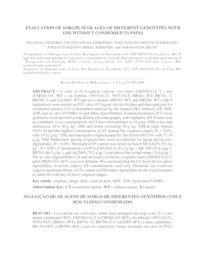Evaluation of sorghum silages of diferent genotypes with and without condensed tannins.
Evaluation of sorghum silages of diferent genotypes with and without condensed tannins.
Autoria: CARNEIRO, H.; SOUZA SOBRINHO, F.; RODRIGUES, J. A. S.; MIRANDA, J. E. C.; BRUM, S. S.
Resumo: A total of 10 Sorghum cultivar: two lines (CMSXS114, T ) and (CMSXS165, WT ), six hybrids ( 9953101,T; 9953130,T; BR601, WT; BR701, T; BR700, T; and AG2005, WT and two varieties (BR501, WT; and BR506, WT) with 8 replications were ensiled in PVC silos of 3 kg per silo for 60 days and then analyzed for condensed tannins (CT) (colorimetric analysis by the butanol-HCl method), CP, NDF, ADF, and in vitro (IVDMD-24 and 48hs) digestibilities. Condensed tannins (CT) from quebracho were purified using affinity chromatography with sephadex LH-20 and used as a standard. Low concentrations of CT have been defined as 10 g kg-1 DM or less and medium as 10 to 40 g kg-1 DM, and levels exceeding 40 g kg-1 DM as high. Hybrid 9953130 had the highest concentration of CT among the sorghum silages (P < 0.05), with 10.62 g kg-1 DM, and among the sorghum panicles, the hybrid 9953101 with 37.39g kg-1 DM. Differences among sorghum lines were not detected for lignin and in vitro digestibility (P > 0.09). The highest CP content was noted for line CMSXS165 (97.4 gkg-1; P < 0.05). Concentrations of CP in CMSXS114 (83.2 g kg-1), BR 700 (76.4 g kg-1), BR701 (80.5 g kg-1), and AG2005 (79.2 g kg-1) were above the overall mean (74.0 g kg-1). The in vitro digestibilities (24 and 48 hours) of the two isogenics lines CMSXS114 (T) and CMSXS165 (WT) were not different. We concluded that the CT level did not affect digestibility; however, relative CT concentrations were low. Therefore, we could not suggest significant effects of CT content on DM intake, digestibility levels or performance in cattle fed with any of these sorghum silages.
Ano de publicação: 2006
Tipo de publicação: Artigo de periódico
Unidade: Embrapa Milho e Sorgo
Observações
1 - Por padrão são exibidas publicações dos últimos 20 anos. Para encontrar publicações mais antigas, configure o filtro ano de publicação, colocando o ano a partir do qual você deseja encontrar publicações. O filtro está na coluna da esquerda na busca acima.
2 - Para ler algumas publicações da Embrapa (apenas as que estão em formato ePub), é necessário ter, no celular ou computador, um desses softwares gratuitos. Sistemas Android: Google Play Livros; IOS: iBooks; Windows e Linux: software Calibre.
Acesse outras publicações
Acesse a Base de Dados da Pesquisa Agropecuária (BDPA) para consultar o acervo completo das bibliotecas da Embrapa.

